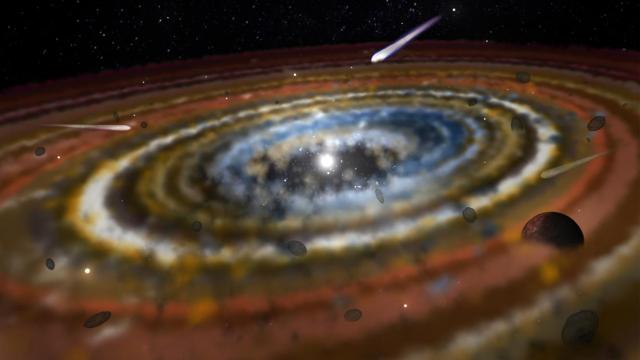NASA’s exoplanet-hunting TESS spacecraft has spotted three comets orbiting a star 64 light-years away, according to a new paper.
Comets in our own solar system are Sun-orbiting objects that develop a cloud and tail from volatile elements when they receive enough solar energy. Scientists have already detected comet-like objects orbiting other stars, but these three are the first to be seen in data from the Transiting Exoplanet Survey Satellite (TESS) mission. The finding demonstrates the kinds of exciting discoveries likely to come from this relatively new mission, which launched in April 2018.
The study’s first author, master’s student Sebastian Zieba from Austria’s University of Innsbruck, was analysing TESS observations of Beta Pictoris, a well-known bright star in the southern sky. Scientists already knew that this star was interesting—it has an exoplanet and a carbon-rich disk. But the data revealed a strange dip, a sign that something was passing in front of the star and dimming its light.
But Beta Pictoris can be a difficult star to study, explained Zieba’s advisor, Konstanze Zwintz. “The star itself oscillates,” she explained. Its light flickers, and because there’s a varying light signal from the star, researchers need to fully understand it in order to pick out the source of the dimming. Both the oscillating star and the dimming from the comet are incredibly weak.
“It’s like you’re on a mountain, light a candle, and go to another mountain a kilometer away and watch the candle flicker,” Zwintz said. “The signals… are even smaller than this.”
After accounting for the star’s flicker and considering any potential noise that TESS itself could introduce, a signal like capital V written in script remained—a sharp downwards dimming, then a less sharp brightening. It looked exactly like a prediction made two decades ago about what exocomets should look like, Zwintz explained. Then, looking even closer in the data, they found two more of these signals, according to the study published in Astronomy and Astrophysics.
Other researchers think it’s cool, too. “It was a prediction made twenty (20!) years ago, that Beta Pictoris would have observable exocomets, so it’s intensely satisfying to see that that is in fact the case,” Jessie Christiansen, astrophysicist at the NASA Exoplanet Science Institute at Caltech, told Gizmodo in an email. “And the data are really clean, which helps when making big claims like ‘exocomets!’”
Of course, this is an interpretation of a blip of data, and more data is needed to better understand what’s going on. It’s unclear how much of what they’re seeing is the cometary nucleus and how much is the tail of gas and dust, and what the density of all this stuff is. Hopefully researchers can one day learn what these exocomets are made of.
The work further demonstrates the power of the TESS mission and the many exciting things it will be able to find outside of our solar system.
